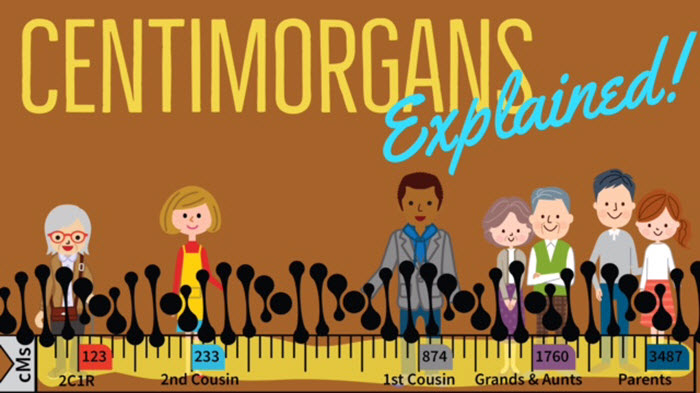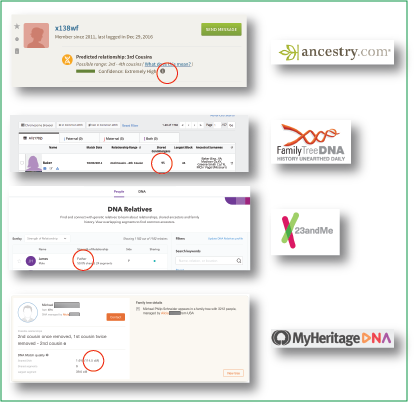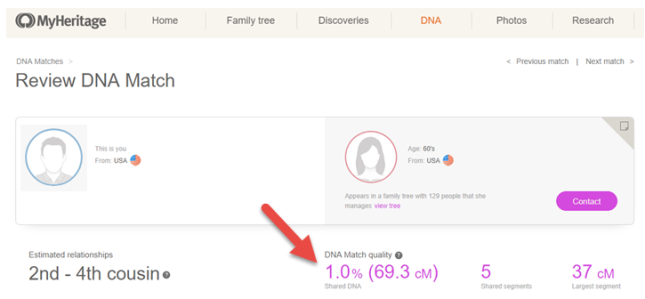What’s a CentiMorgan, Anyway? How DNA Tests for Family History Measure Genetic Relationships
If you’re doing DNA tests for family history, you may see lots of predicted cousin matches: 2nd, 3rd, 4th, etc…..But what does that predicted genetic relationship actually mean? Learn about centimorgans, the powerful genetic genealogy unit of measure, and how it helps your research.

How DNA Tests Measure Genetic Relationships
 When we are looking at genetic relationships, there are also many ways we can measure them. But ultimately, we want the testing company to tell us how likely it is that a particular individual shares a single, recent common ancestor with us. One factor in this calculation is to take into account the total amount of DNA we share with that match.
When we are looking at genetic relationships, there are also many ways we can measure them. But ultimately, we want the testing company to tell us how likely it is that a particular individual shares a single, recent common ancestor with us. One factor in this calculation is to take into account the total amount of DNA we share with that match.
Currently, all the testing companies are reporting this sum in centimorgans (cMs). Every company reports to you the total number of shared cMs, as outlined below.
 AncestryDNA: Click on the match to access the personal profile page for that match. In the second section, under Predicted Relationship, you will see the confidence level. To the right of the confidence level, you will see a grey circle with a little “i” in it. Clicking there will show you the total amount of shared cMs as well as how many pieces of DNA you share.
AncestryDNA: Click on the match to access the personal profile page for that match. In the second section, under Predicted Relationship, you will see the confidence level. To the right of the confidence level, you will see a grey circle with a little “i” in it. Clicking there will show you the total amount of shared cMs as well as how many pieces of DNA you share.- Family Tree DNA: On the main match page for your Family Finder results, you will see the total amount of shared cMs in the third column.
- 23andMe: You can see the percentage of shared DNA from the main DNA Relatives home page. To convert the percentage into centimorgans, just multiply your percentage by 68 (that will at least get you close). You can also see total shared cMs in the chromosome browser tool (go to Tools > DNA Relatives > DNA).
- MyHeritageDNA: The total amount of shared DNA is shown on the main match page under the title Match Quality. MyHeritage also has a new DNA Match Review page. Click here to read more about that.
Centimorgan: A Genetic “Crystal Ball”
 It is very tempting to think of a cM just like you would think of an inch or a centimeter, and for all practical purposes, that is okay. But it is actually much more complicated than that.
It is very tempting to think of a cM just like you would think of an inch or a centimeter, and for all practical purposes, that is okay. But it is actually much more complicated than that.
A cM is actually more like a crystal ball: it helps us predict how likely a piece of DNA looks exactly as it did a generation ago. This, in turn, helps us calculate how far back we should be looking for the common ancestor between two people.
But for our practical purposes, you can use the total amount of shared DNA, in combination with this chart compiled by Blaine Bettinger and the Shared cM Project, to better assess your genealogical relationship with your match based on your genetics.
To use the chart, take the total amount of shared DNA you have with a match, and look up that number in the chart to get an idea of what kind of genealogical relationship might best fit the genetics that you see. For example, if I share 69 cM with my match, we might be third cousins. But we might also be second cousins once or twice removed.

How do you figure out which one? Simply put: do genealogy research! It’s time to use traditional records and research skills to better understand the genetic clues in your family history mysteries.
My series of DNA quick reference guides can help you get the most out of your DNA tests for family history. I definitely recommend the value-priced bundle of all 10 guides. But I especially recommend the guides listed below if you’re to the point where you’re trying to understand what genetic relationships mean:
- A Guide to AncestryDNA
- A Guide to Family Finder at Family Tree DNA
- A Guide to 23andMe DNA
- Breaking Down Brick Walls with DNA
- Organizing Your DNA Matches
Thanks for sharing this post with someone who would enjoy reading it! You’re a gem!
Disclosure: This article contains affiliate links and Genealogy Gems will be compensated if you make a purchase after clicking on these links (at no additional cost to you). Thank you for supporting Genealogy Gems!




